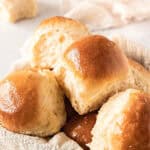
Easy Dinner Rolls (old fashioned yeast recipe)
These classic rolls can be plain or flavored. They use few ingredients and can be made in advance and frozen.
Servings 15 rolls
Ingredients
- 1 cup whole milk
- ¼ cup sugar
- 1 teaspoon salt
- ¼ cup unsalted butter at room temperature
- 4 ½ teaspoons active-dry yeast 2 packets
- ½ cup tap water warm (not hot)
- 2 eggs at room temperature and lightly beaten before adding
- 5 to 5 ½ cups all-purpose or bread flour
- 3 tablespoons unsalted butter melted, to brush rolls
Instructions
- Scald 1 cup whole milk, remove from heat and add ¼ cup sugar, 1 teaspoon salt and ¼ cup unsalted butter. Stir to dissolve and cool to lukewarm before using.
- Stir 4 ½ teaspoons active-dry yeast in ½ cup tap water in the bowl of a stand mixer or a large mixing bowl if making them by hand.
- Add lukewarm milk mixture, 2 eggs lightly beaten, and 2 cups all-purpose or bread flour. Stir to mix with a silicon or wooden spoon; it will be shaggy at first. Attach the dough hook if using the mixer, or transfer the dough to a clean counter and start kneading.
- Add 3 more cups of flour, ½ to 1 cup at a time and knead until you have a soft dough. In the mixer, it’ll take 7-8 minutes at medium speed and will start to leave the sides of the bowl. By hand, it'll take about 10 minutes, and you have to feel it to know if it needs more flour. The dough should be supple and elastic. Extra flour: if the dough is wet and sticky, use the extra ½ cup of flour, adding a few tablespoons at a time the dough should feel firm but not be dry or too stiff.
- Place in a lightly greased bowl (with butter or oil), turning to grease it all. Cover with plastic wrap and let the dough rise until doubled in a warm place. It should take about 30 to 45 minutes, maybe 1 hour, depending on the temperature of the room.
- Gently punch down and turn it out onto a lightly floured surface.
- Knead a few times to gather and cut about 15 small equal pieces, about 2 ounces or 60 grams each. You can eyeball them or weigh them for more accuracy.
- Butter a pan that will accommodate them. Roll them into tight balls, pinching underneath to seal and place them, smooth side up, barely touching each other. You might need more than 1 pan, depending on the size and number of rolls.
- Cover with a clean kitchen towel and let rise until doubled, about 30 minutes. Meanwhile, preheat the oven to 350°F (180°C).
- Brush the top of the bread with 3 tablespoons unsalted butter, being careful not to deflate the dough.
- Bake the rolls until puffed and shiny on top, about 20 minutes. They should feel firm to the touch and have no wet strands if you carefully lift the top of the middle ones.
- Let them cool on a wire rack. Store leftovers at room temperature in an airtight container for a few days or freeze for a month.
Notes
Organization: read the recipe first and ensure you have ingredients at the correct temperature, utensils and equipment needed, enough workspace and have planned for rising times. This will make the process so much easier.
Baking time: consider that all ovens and pans are different, even if they look similar. The baking time in my recipes is as accurate as possible, but it might take you more or less time. You can use an oven thermometer to check that your oven is at the right temperature. I recommend tracking how your oven works and what tiny details you might need to adjust.
Variations: substitute 1 to 1 ½ cups finely milled whole wheat flour for some of the all-purpose. Add a few tablespoons of chopped herbs like rosemary, thyme or oregano (my favorites) or parsley. Add chopped garlic or onions. Or a spice like smoked paprika or chili powder for a spicy kick.